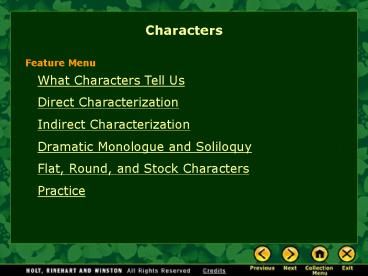Characters - PowerPoint PPT Presentation
1 / 16
Title:
Characters
Description:
Title: Elements of Literature: Character Author: Amber Last modified by: Marie Calorio Created Date: 10/26/2004 1:31:09 PM Document presentation format – PowerPoint PPT presentation
Number of Views:253
Avg rating:3.0/5.0
Title: Characters
1
Characters
Feature Menu
What Characters Tell Us Direct Characterization In
direct Characterization Dramatic Monologue and
Soliloquy Flat, Round, and Stock
Characters Practice
2
What Characters Tell Us
What can we learn from fictional characters?
We can learn about
- encounters with discrimination
- conflicts between old and new traditions
- struggles for independence and acceptance
- triumphs, fears, and love
3
What Characters Tell Us
Characters are the actors in a story. When they
behave in convincing ways, they make us believe
in them and draw us into their fictional worlds.
By reading about their struggles, we often learn
something about ourselves.
End of Section
4
Direct Characterization
Direct CharacterizationThe writer tells readers
directly what a character is like.
. . . he was a simple, good-natured man he was
moreover a kind neighbor and an obedient,
henpecked husband. from Rip Van Winkle by
Washington Irving
End of Section
5
Indirect Characterization
Indirect CharacterizationThe writer reveals
characters traits through
- appearance
- dialogue
- private thoughts
- actions
- effects on others
6
Indirect Characterization
Appearance The way writers describe characters
appearancephysical features, clothing, and
general demeanorprovides insight into their
personalities.
(After his twenty-year nap) The appearance of
Rip, with his long grizzled beard, his rusty
fowling piece, his uncouth dress, . . . soon
attracted the attention of the tavern
politicians. from Rip Van Winkle by Washington
Irving
7
Indirect Characterization
Dialogue Dialogue can reveal a lot about
characters. Pay attention not only to what
characters say but also how they say it.
(Entering the village after his twenty-year
nap) God knows, exclaimed Rip . . ., Im not
myself.Im somebody elsethats me
yondernothats somebody else got into my
shoesI was myself last night but I fell asleep
on the mountainand theyve changed my gunand
everythings changedand Im changedand I cant
tell whats my name, or who I am! from Rip Van
Winkle by Washington Irving
8
Indirect Characterization
Private Thoughts Characters private thoughts can
reveal what they think, feel, want, or fear.
(Rip learns that friends have passed away in his
absence) Rips heart died away, at hearing of
these sad changes in his home and his friends,
and finding himself thus alone in the world . . .
he had no courage to ask after any more friends,
but cried out in despair, Does nobody here know
Rip Van Winkle? from Rip Van Winkle by
Washington Irving
9
Indirect Characterization
Actions Characters actionswhat they do and how
they do ittell a great deal about them.
He assisted at their sports, made their
playthings, taught them to fly kites and shoot
marbles, and told them long stories. . . . from
Rip Van Winkle by Washington Irving
10
Indirect Characterization
Effects on Others The effect a character has on
others also helps readers understand what the
character is like.
The children of the village . . . would shout
with joy whenever he approached. . . . Whenever
he went dodging about the village he was
surrounded by a troop of them . . . and not a dog
would bark at him throughout the
neighborhood. from Rip Van Winkle by
Washington Irving
11
Indirect Characterization
Quick Check
In what indirect ways does the writer reveal
character in this passage?
Rip would never refuse to assist a neighbor
even in the roughest toil, and was a foremost man
at all country frolics for husking corn, or
building stone fences the women of the village
too used to employ him to run their errands . . .
from Rip Van Winkle by Washington Irving
End of Section
12
Indirect Characterization
Quick Check
In what indirect ways does the writer reveal
character in this passage?
Rip would never refuse to assist a neighbor
even in the roughest toil, and was a foremost man
at all country frolics for husking corn, or
building stone fences the women of the village
too used to employ him to run their errands . . .
from Rip Van Winkle by Washington Irving
The writer describes Rips actionshe always
helps others.
13
Dramatic Monologue and Soliloquy
Characters are also important in poetry and
plays. One way that poets and playwrights can
develop characters is by letting them speak for
themselves.
- A dramatic monologue is a poem in which a single
character talks to one or more silent listeners.
- A soliloquy is a scene in a play in which a lone
character tells his or her thoughts directly to
the audience.
End of Section
14
Flat, Round, and Stock Characters
Flat characters
- have only one or two character traits
- can be described in a few words
- are usually minor characters
15
Flat, Round, and Stock Characters
Round characters
- have many character traits
- are complex, like real people
- are often major characters
16
Flat, Round, and Stock Characters
Stock characters
- fit readers preconceived ideas about types,
such as mad scientists or nagging wives
- are not complex like real people
Rips wife kept continually dinning in his
ears about his idleness, his carelessness, and
the ruin he was bringing on the family. Morning,
noon, and night, her tongue was incessantly
going. . . . from Rip Van Winkle by Washington
Irving
End of Section
17
Practice
Pick a character in a short story
you have read. Review the story, and identify two
or three of the characters traits. List details
in the story that illustrate those traits. Then,
identify which literary device (such as
narration, dialogue, or description) helped you
identify each trait.
Character Traits Supporting Details Literary Device Used
End of Section































